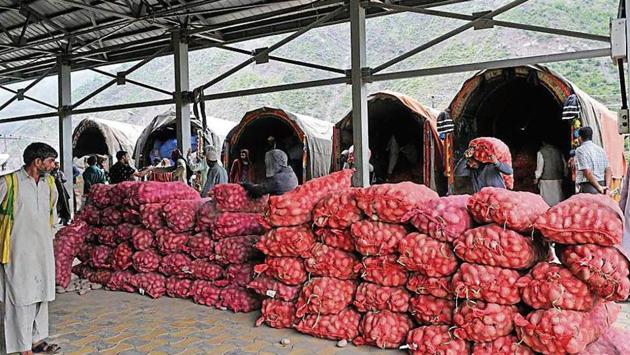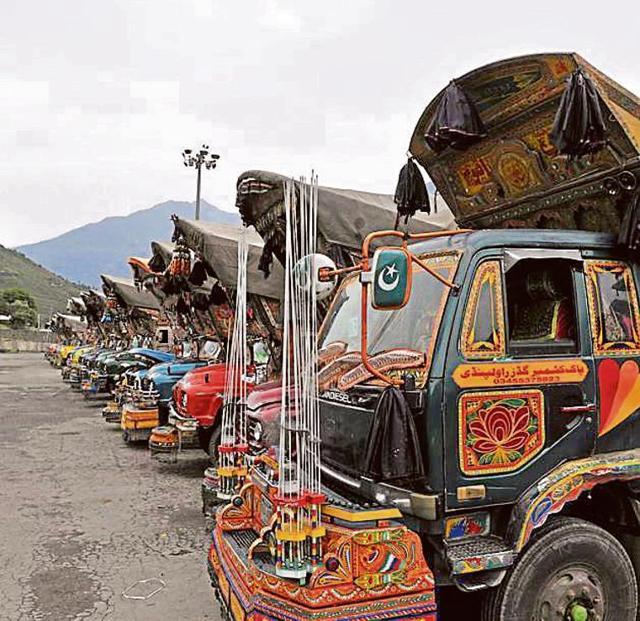Border business: Where Kashmir unites India, Pakistan via trade (original) (raw)
Far from terror, trade quietly flourishes on this India-Pakistan frontier. The recent hostilities between the two countries on the Line and Control and border elsewhere have had no impact on the cross-LoC trade. Rather, trade has touched Rs 5,000 crore and is silently emerging as the biggest confidence-building measure (CBM).

The goods brought in from Pakistan being unloaded at the Trade Facilitation Centre at Salamabad near Uri.(Waseem Andrabi/HT)
Every morning from Tuesday to Friday since the trade started in 2008, brightly painted trucks from Pakistan-occupied Kashmir (PoK) make for a beautiful sight as they roll into the Trade Facilitation Centre (TFC) at Salamabad near Uri. As the vehicles enter, coolies in pink uniforms rush to unpack goods brought from Chikoti in Muzaffarabad, 20 km away.
From both sides of Kashmir, traders are allowed to deal in 16 items though they have been seeking that the number of items be increased. The items traded include spices, vegetables, dry and fresh fruits, carpets, rugs, embroidery items, shawls, paper machie goods, clothes and wooden furniture.
Uri sub divisional magistrate Baseer-ul-Haq, who is also the custodian of the cross-LoC trade, says, “Since 2008, items worth Rs 4,672 crore have been traded through Kaman and the quantum of trade is going up with every passing day.”
Despite the border flare-ups and lack of facilities, trade has never stopped since it was opened. It’s unlike the trade at Poonch-Chakanda Bagh that sees frequent disruptions due to cross-LoC firing. Whether it was Mumbai, Pathankot or the attack on the Uri brigade headquarters, trade here did not stop. Last year, four militants were killed in an encounter at Kalgai village near the TFC on the road to Kaman but even that did not impact trade.

A fleet of Pakistani trucks. (Waseem Andrabi/HT)
Upgrade for transparency
Haq says new facilities have been created to boost trade. “Our aim is to digitise the trade. We have sought truck scanners to make trade transparent,’’ he says. At the TFC, the trucks are verified before the goods are unloaded under security watch. After starting early in the morning, they cross Kaman Bridge in the evening after formalities are completed. The traders say fruit, vegetables and spices are in demand.
Salamabad Cross LoC Trade Union president Hilal Ahmad Turkey says despite the shortcomings, trade has been good.
“It’s one of the biggest CBMs between India and Pakistan involving the two parts of Kashmir, and it goes on silently. If governments from both sides provide facilities, trade will see a fourfold rise and this area can become a business hub. It will bring down tension,” he says.
“In the beginning, 646 traders got registered with this trade. At that time, the trade was free for all. Now, the government has streamlined it. Many traders left the business after the government failed to enhance the facilities at the trade centre such as phone lines and banking facilities,” he says.
“Traders can despatch or receive only 35 trucks a day. This is a handicap,’’ says Turkey, who leads 240 traders from Kashmir.
Abdul Rashid Bhat, a trader from Baramulla, says the government should not only increase the number of listed items but also develop a software that will register each transaction. “This will increase the quantum of trade and draw more people towards this business,” he says.
Another trader, Bashir Ahmad, says the government should upgrade the centre on a par with the one at Attari near Amritsar. “There are many who are opposed to this trade but so far it has not only survived but also flourished,” he says.
“This is not only about trade between two nations, it is a sign of love and brotherhood and should be strengthened. People running this trade are not mere traders but they are builders of peace,’’ says Turkey. “We have set up a body of traders of both parts of Kashmir and Jammu regions to strengthen this trade,” he says.
Choudhary Mohammad Aslam, a custodian of the cross-LoC trade, says this centre has the potential to grow. “The upgrade proposal has been sent to the home ministry,” he says.
Bridging Kashmirs
Uri-based Abdul Ahad Mangral, the general secretary of the Cross-LoC Trade Union, says, “Besides acting as a bridge between the two Kashmirs, trade is helping bring divided families closer. My caste is Mangral; we are only a few thousand on this side. Most members of our community live across the LoC as our ancestors came from Kotli. This trade gives us a chance to revive our relations through business.’’
He, however, says that trade runs on barter and traders still use old methods to do business. “I hope soon we will have banking and other facilities in this age of technology.’’
Mangral says when tension peaked between the armies on the LoC, it was trade that eased the situation. “It seems both India and Pakistan want this route to stay open. Trade has helped bring down hostilities and tension is at the lowest in Uri,” he says.
Since 2008, there have been three incidents when contraband hidden in goods was recovered from trucks from Muzuraffabad.
“The trucks are with the police. Such incidents give the trade a bad name. But don’t drugs come through Amritsar and other routes?” says Shabir Ahmad, a trader.
For traders, social media has become a lifeline. They use messaging apps to stay in touch with their counterparts in PoK. Security personnel say that truck scanners promised by the government for foolproof security are needed.
“This is a sensitive spot and the requirement has been flagged to the defence ministry. There have been instances when weapons were seized from trucks coming from PoK,” a senior army officer posted in Uri said on condition of anonymity as he is not authorised to speak to the media.